| |
|
|
|
|
|
|
|
|
|
|
| |
| |
 |
|
| |
田润德 编译文/图 2020-08-18
20:36 |
|
| |
|
|
|
|
| |
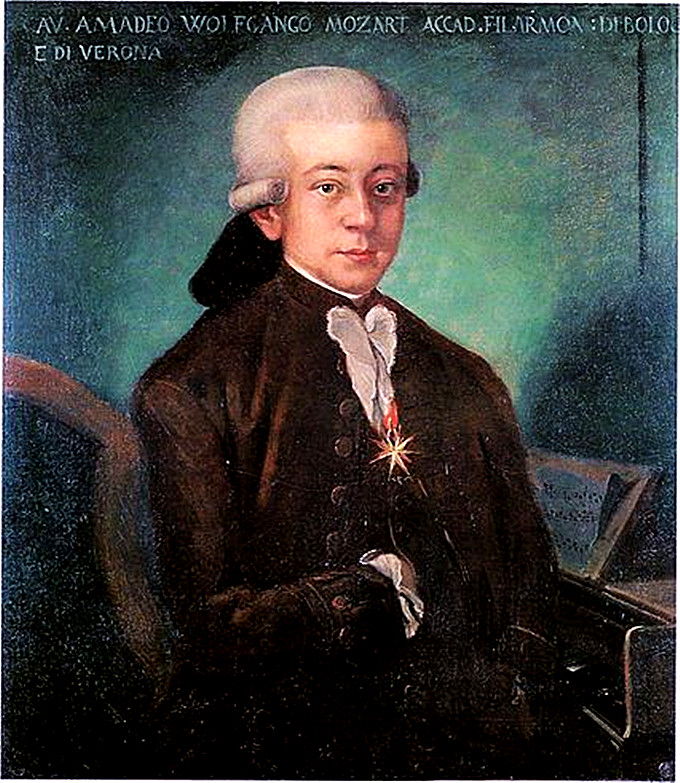 |
|
|
|
| |
沃尔夫冈·阿玛迪斯·莫扎特(Wolfgang
Amadeus Mozart 1756-1791) |
|
|
|
| |
|
|
|
|
| |
音乐会·卡拉扬·卡拉扬纪念DVD19·柏林建城750周年纪念音乐会 |
|
|
|
| |
柏林建城750周年纪念音乐会
莫扎特第十七号嬉游曲 K 334
理查·施特劳斯交响诗《查拉如斯特拉如是说》
1987年5月1日 |
|
|
|
| |
|
|
|
|
| |
音乐历史上的今天
1773年8月18日莫扎特:《第17号嬉游曲》首演于维也纳梅斯玛博士的花园音乐会。
1773年的今天,莫扎特正值十七岁风华正茂,早已从一个名扬天下的音乐神童成长为一个满腹诗书的翩翩少年,列奥波德·莫扎特带领一家人从1769年开始的三次意大利之旅,
刚刚结束。第一次意大利之旅,西至意大利的都灵,南至那不勒斯,十三岁的莫扎特正值美好年华,一路走来一路歌,观摩作曲、
走一路写一路,演奏、遍访名人
,研究了大量的欧洲乃至于世界的文化,所以此时莫扎特生正逢时,血气方刚,创造了很多辉煌的乐章,正是读万卷书不如行万里路;1771年第二次意大利之旅;1772年第三次意大利之旅走遍了意大利的山山水水。莫扎特从意大利之旅归来,回到家乡萨尔茨堡创作了这首《第
十七号嬉游曲》k334,并且在1773年8月18日首演于维也纳梅斯玛博士的花园音乐会。
这首嬉游曲中的小步舞曲常常被独奏家们用在音乐会上单独演奏,包括大名鼎鼎的海菲兹就把这首小步舞曲技巧部分改编成连顿弓演奏,更给这首曲子增添了无穷的
意趣,作为保留曲目,精彩在独奏音乐会上演奏,
给莫扎特的这首小步舞曲更加流光溢彩。
在乐队小步舞曲时,这首清纯的小步舞曲就是最好的检验,而柏林爱乐合奏中,我们
看到如此众多的音乐群,都如同一个人演奏一般,小提琴演奏明确的重奏,不但音色纯正而且每一个音符都清晰可辨,莫扎特的音乐确实高贵清纯,
说明柏林爱乐的演奏家们个个不但是独奏家的水准,而且还兼具极高的室内乐合奏水平,以及多年在一起磨合的合作经验,使得这首乐曲在古典音乐中的百花园中,争相吐艳。而且多少年来王宫贵族们都踩着小步舞曲的节奏,偏偏起舞,所以这首小步舞曲的流行,所以他几百年了一直成为了人们非常钟情和喜爱的一首莫扎特名曲。
嬉游曲(divertimento)原为18世纪欢娱宾客的器乐重奏组曲,常由3~10余件管弦乐器混合演奏,包含4个以上乐章,以舞曲(最常见的是小步舞曲,可以不止一首)、进行曲、变奏曲为主,形式与小夜曲相仿
。J.海顿和W.A.莫扎特都作有大量嬉游曲。F.舒伯特的《匈牙利风格嬉游曲》是以匈牙利曲调为基础的幻想曲。法国作曲家A.鲁塞尔为钢琴和5件管乐器作的嬉游曲和F.布索尼为长笛和乐队作的嬉游曲,都是20世纪的作品。B.巴托克、I.F.斯特拉文斯基、H.W.亨策也写过不同形式的嬉游曲,插入歌剧、舞剧和其他戏剧的游艺舞曲中。
嬉游曲(divertimento)为西方古典音乐常用曲式之一,是一种流行于十八世纪的轻组曲。在当时主要用在上层阶级与宫廷生活(主要是在奥地利)的娱乐、社交、庆祝场合,相对于小夜曲是用于室外的演奏,嬉游曲主要是用在室内的演奏。嬉游曲的语源来自于意大利文的"divertire",有使人欢乐、消遣的意思。作为小型室内合奏器乐曲,它的乐器组成、乐章数目以及曲式都十分自由。合奏人数通常在三到八人之间,通常由三到十个小乐章构成,每个乐章的体裁通常以舞曲(尤其是小步舞曲)、进行曲、变奏曲、奏鸣曲式等为主,并没有严格限定。
在十八世纪,海顿与莫札特都写过大量的嬉游曲。嬉游曲形式到了十九世纪就很少有人使用,直到二十世纪初室内乐以及复古风吹起,才有一些现代作曲家又尝试嬉游曲的写作。
嬉游曲(divertimento)原为18世纪欢娱宾客的器乐重奏组曲,常由3~10余件管弦乐器混合演奏,包含4个以上乐章,以舞曲(最常见的是小步舞曲,可以不止一首)、进行曲、变奏曲为主,形式与小夜曲相仿。J.海顿和W.A.莫扎特都作有大量嬉游曲。F.舒伯特的《匈牙利风格嬉游曲》是以匈牙利曲调为基础的幻想曲。法国作曲家A.鲁塞尔为钢琴和5件管乐器作的嬉游曲和F.布索尼为长笛和乐队作的嬉游曲,都是20世纪的作品。B.巴托克、I.F.斯特拉文斯基、H.W.亨策也写过不同形式的嬉游曲,插入歌剧、舞剧和其他戏剧的游艺舞曲中。
嬉游曲(divertimento)为西方古典音乐常用曲式之一,是一种流行于十八世纪的轻组曲。在当时主要用在上层阶级与宫廷生活(主要是在奥地利)的娱乐、社交、庆祝场合,相对于小夜曲是用于室外的演奏,嬉游曲主要是用在室内的演奏。嬉游曲的语源来自于意大利文的"divertire",有使人欢乐、消遣的意思。作为小型室内合奏器乐曲,它的乐器组成、乐章数目以及曲式都十分自由。合奏人数通常在三到八人之间,通常由三到十个小乐章构成,每个乐章的体裁通常以舞曲(尤其是小步舞曲)、进行曲、变奏曲、奏鸣曲式等为主,并没有严格限定。
在十八世纪,海顿与莫札特都写过大量的嬉游曲。嬉游曲形式到了十九世纪就很少有人使用,直到二十世纪初室内乐以及复古风吹起,才有一些现代作曲家又尝试嬉游曲的写作。
今日视频:1、卡拉扬在柏林建城750周年纪念音乐会上指挥柏林爱乐演奏莫扎特《第17号嬉游曲》k334;2、莫扎特《小步舞曲》配舞版,画面很美
;3、海菲兹 & 莫扎特-D大调小步舞曲 & 小提琴(改编自莫扎特《第17号嬉游曲》。
|
|
|
|
| |
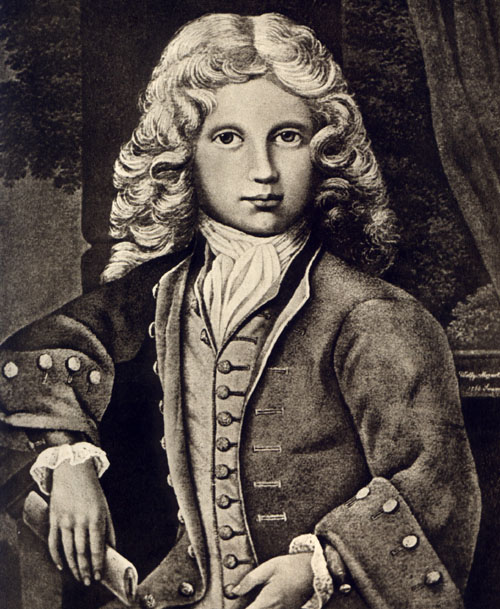 |
|
| |
少年就以神童名扬天下的莫扎特(Wolfgang
Amadeus Mozart ) |
|
|
|
| |
沃尔夫冈·阿玛多伊斯·莫扎特简介 |
|
|
|
| |
Introduction to
Wolfgang Amadeus Mozart |
|
|
|
| |
沃尔夫冈·阿玛多伊斯·莫扎特(Wolfgang Amadeus
Mozart,1756年1月27日-1791年12月5日),出生于神圣罗马帝国时期的萨尔兹堡。欧洲古典主义音乐作曲家。1760年,莫扎特开始学习作曲。1763年至1773年,莫扎特随父亲列奥波尔得·莫扎特在欧洲各国进行旅行演出。1781年,莫扎特到维也纳开始10年的创作生涯。1791年12月5日0时55分,莫扎特逝世,享年35岁,死因不明。莫扎特留下的重要作品总括当时所有的音乐类型。他谱出的协奏曲、交响曲、奏鸣曲、小夜曲、嬉游曲后来成为古典音乐的主要形式。
1756年1月27日,莫扎特生于奥地利的萨尔茨堡一位宫廷乐师的家庭,原籍是德国,他的父亲列奥波尔得·莫扎特是那座城中宫廷天主教乐团的小提琴手,也是一位作曲家;母亲安娜·玛丽亚·莫札特也热衷于音乐并会拉大提琴和小提琴。莫扎特是家中最小的孩子排行第七。
1760年,4岁的莫扎特跟父亲列奥波尔得·莫扎特学习钢琴并开始作曲。1762年,6岁的莫扎特在父亲的带领下到慕尼黑、维也纳、普雷斯堡作了一次试验性的巡回演出。1763年6月至1773年3月,莫扎特与父亲先后到德国、法国、英国、荷兰、意大利等国进行为期十年的旅行演出。这次演出让莫扎特对当时最先进的意大利歌剧、法国歌剧、德国器乐等体裁都有了认识,还结识了J.C.巴赫、G.B.马蒂尼、G.B.萨马蒂尼等作曲家并学习到他们的作曲技术,这时的作品已经显示莫扎特创作体裁的广泛性和他对歌剧创作的兴趣。
1773年底,莫扎特与父亲返回萨尔茨堡。此时的莫扎特对自己卑微的奴仆乐师地位感到不满,为了争取人身与创作的自由,他经过激烈的斗争,终于在1777年9月获得大主教的同意,又随母亲进行了两年的旅行演出。为了另谋职位,以便永远离开萨尔茨堡,他先后在慕尼黑和曼海姆教学、演出,进一步加深了对不平等制度的认识和体会。在曼海姆时,他得到一些市民音乐家的帮助与同情,并接触到当时欧洲重要的曼海姆乐派,听到第一流管弦乐队的演奏。
1778年5月,莫扎特抵达巴黎,由于母亲病逝,加上未能谋到职位,于是在1779年1月返回萨尔茨堡。这一时期,莫扎特在曼海姆创作了2首长笛协奏曲、1首双簧管协奏曲、7首钢琴小提琴奏鸣曲、3首钢琴奏鸣曲,这些作品反映了曼海姆乐派的影响。1780年,莫扎特完成歌剧《伊多梅纽》。这一时期莫扎特的作品严谨,在内容上反映了当时狂飙运动思潮的影响,在形式上出现了新的要素,如奏鸣曲式第一乐章的呈示部,出现了与第一主题相对比的第二(或更多的)主题在再现部中,常常改换主题出现的次序,有时对主题材料也进行了不同于呈示部的处理,在第一、二乐章间,有了强烈的力度对比,这些手法,增强了他的音乐作品的戏剧性,使“古典奏鸣曲式”进一步形成。
1781年6月,莫扎特再也无法忍受大主教的凌辱,毅然向大主教提出了辞职,成为欧洲历史上第一位公开摆脱宫廷束缚的音乐家,到维也纳谋生。之后他虽然名义上是一位自由作曲家,实际上仍然无力抗争封建社会对他的压迫。生活的磨难对他的思想和创作产生了深刻的影响,在维也纳的10年,成为他创作中最重要的10年。1782年7月,莫扎特创作的《后宫诱逃》在维也纳布尔格剧院首演。
1784年,他参加了共济会,对它所宣扬的自由、平等、博爱的思想有强烈共鸣,并在这种思想的启示下创作新型作品。1785年,一度倒闭了的维也纳民俗歌剧院开始恢复,莫扎特有了从事歌剧创作的机会,创作了一部喜剧型歌剧《剧院经理》。1786年,创作歌剧《费加罗的婚礼》。1787年,莫扎特完成歌剧《唐璜》。1790年1月,莫扎特的歌剧《女人心》上演。1791年,莫扎特创作歌剧《蒂托的仁慈》但未获成功。9月,完成最后一部歌剧《魔笛》。之后莫扎特开始创作大型宗教音乐作品《安魂曲》,于12月5日0时55分《安魂曲》还未完成莫扎特就离奇死亡,享年35岁,入葬于维也纳。 |
|
|
|
| |
Wolfgang Amadeus
Mozart (January 27, 1756 - December 5, 1791) was born in Salzburg during
the Holy Roman Empire. European classical music composer. In 1760,
Mozart began to study composition. From 1763 to 1773, Mozart traveled
with his father, Leopold Mozart, throughout Europe. In 1781, Mozart went
to Vienna to begin a 10-year creative career. At 0:55 on December 5,
1791, Mozart died at the age of 35, of unknown causes. Mozart left
behind important works that encapsulate all musical genres of the time.
He composed concertos, symphonies, sonatas, serenades, and rogues that
later became the main forms of classical music.
Mozart was born on January 27, 1756, in Salzburg, Austria, to a family
of court musicians. His father, Leopold Mozart, was a violinist and
composer in the court Catholic orchestra of that city. Her mother, Ana
Maria Mozart, is also passionate about music and plays the cello and
violin. Mozart was the seventh youngest child.
In 1760, at the age of four, Mozart studied piano with his father,
Leopold Mozart, and began composing music. In 1762, at the age of six,
Mozart was led by his father to Munich, Vienna, and Presburg for an
experimental tour. From June 1763 to March 1773, Mozart and his father
successively traveled to Germany, France, England, the Netherlands,
Italy and other countries for a ten-year tour. This performance allowed
Mozart to have an understanding of the most advanced Italian opera,
French opera, German instrumental music and other genres at the time,
and also met J.C. Bach, G.B. Martini, G.B. Sammartini and other
composers and learned their compositional techniques, and the works at
this time already show the breadth of Mozart's genre and his interest in
opera creation.
At the end of 1773, Mozart returned to Salzburg with his father. At this
time, Mozart was dissatisfied with his humble status as a slave
musician, and in order to fight for personal and creative freedom, he
fought fiercely, and finally got the consent of the archbishop in
September 1777, and traveled with his mother for two years. In order to
find another job so that he could leave Salzburg for good, he taught and
performed in Munich and Mannheim, further deepening his understanding
and experience of the unequal system. While in Mannheim, he received the
help and sympathy of a number of civic musicians, and was exposed to the
important Mannheim music school in Europe at the time, and heard the
first-class orchestra.
In May 1778, Mozart arrived in Paris, but due to the death of his mother
and the failure to find a post, he returned to Salzburg in January 1779.
During this period, Mozart composed two flute concertos, one oboe
concerto, seven piano and violin sonatas, and three piano sonatas in
Mannheim, which reflected the influence of the Mannheim School. In 1780,
Mozart completed the opera Idomenius. In this period, Mozart's works
were rigorous, reflecting the influence of the storm movement in
content, and new elements appeared in form, such as the exposition
section of the first movement of Sonata Form, the second (or more)
themes compared with the first theme appeared in the reproduction
section, often changing the order of theme appearance, and sometimes the
theme materials were treated differently from the exposition section. In
the first and second movements, there is a strong contrast of strength,
and these techniques enhance the drama of his musical works, so that the
"classical sonata form" further formed.
In June 1781, Mozart could no longer endure the abuse of the archbishop,
and decided to resign to the archbishop, becoming the first musician in
European history to publicly free himself from the bondage of the court,
and went to Vienna to make a living. After that, although he was
nominally a free composer, in fact, he was still unable to fight against
the oppression of the feudal society. The tribulations of life had a
profound impact on his thinking and creation, and the 10 years in Vienna
became the most important 10 years in his creation. In July 1782,
Mozart's "Escape from the Harem" was premiered at the Bolger Theatre in
Vienna.
In 1784, he joined the Freemasonry, which advocated the idea of freedom,
equality, fraternity has a strong resonance, and under the inspiration
of this idea to create new works. In 1785, the once closed Vienna Folk
Opera began to recover, and Mozart had the opportunity to engage in
opera creation, creating a comedy opera "Theater Manager". In 1786, he
composed the opera The Marriage of Figaro. 1787 Mozart completed the
opera Don Giovanni. In January 1790, Mozart's opera The Heart of a Woman
was performed. In 1791, Mozart wrote an opera, Tito's Mercy, but it was
not successful. In September, he completed his last opera, The Magic
Flute. After Mozart began to create a large-scale religious music work
"Requiem", on December 5 0:55 "Requiem" has not been completed Mozart
mysteriously died, aged 35, was buried in Vienna. |
|
|
|
| |
|
|
|
|
| |
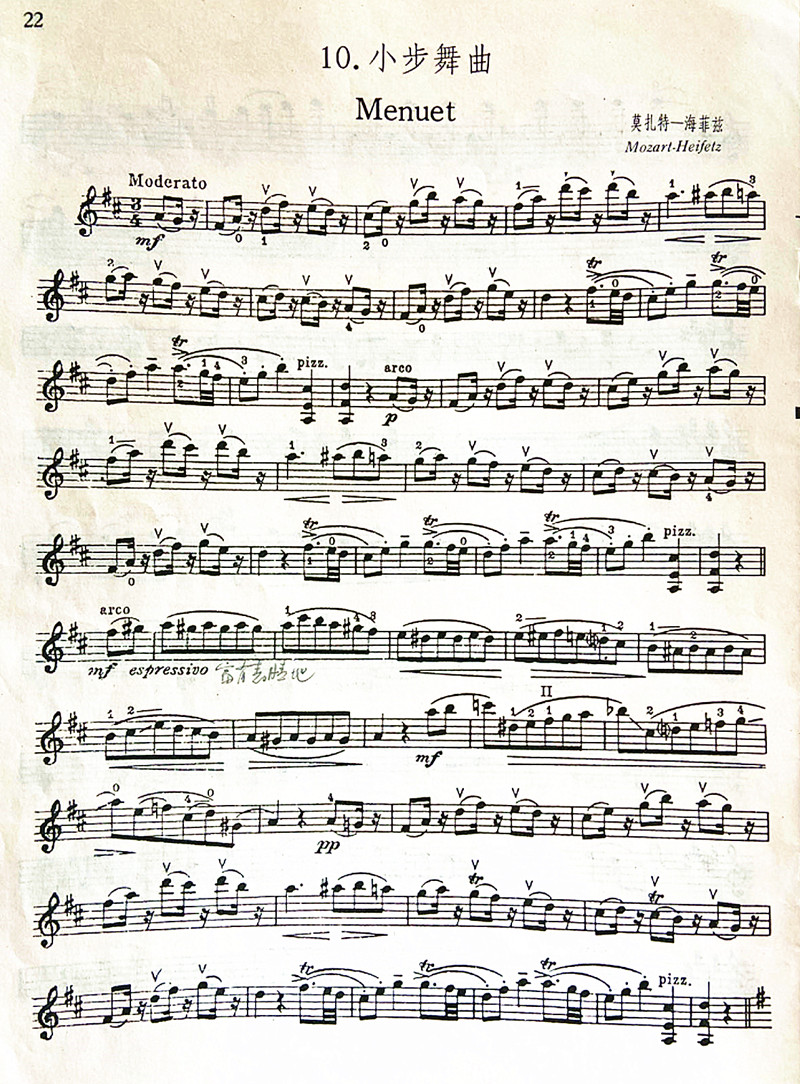 |
|
| |
海菲兹 &
莫扎特-D大调小步舞曲 & 小提琴乐谱第一页 |
|
|
|
| |
Heifetz & Mozart - Minuet in D Major & Violin
Sheet music page 1 |
|
|
|
| |
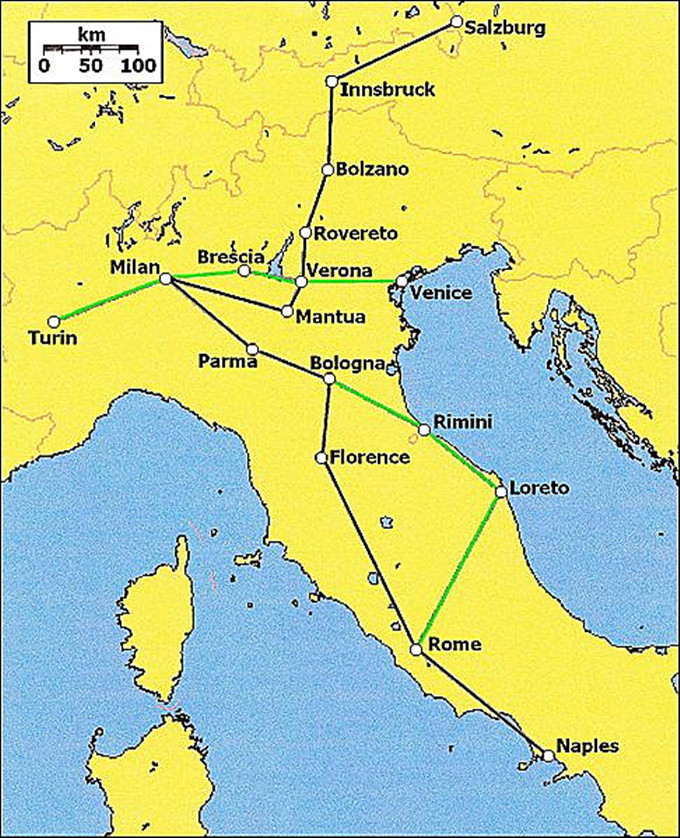 |
|
| |
莫扎特一家1769年第一次意大利之旅 |
|
|
|
| |
The Mozart family
made their first trip to Italy in 1769 |
|
|
|
| |
上图黑线是莫扎特一家行程的主线,绿线是临时拜访地,西至意大利的都灵,南至那不勒斯,十三岁的莫扎特正值美好年华,一路走来一路歌,观摩作曲、
走一路写一路,演奏、遍访名人
,研究了大量的欧洲乃至于世界的文化,所以此时莫扎特生正逢时,创造了更加辉煌的乐章,正是读万卷书不如行万里路;1771年第二次意大利之旅;1772年第三次意大利之旅。莫扎特在意大利创作了这首《第七号嬉游曲》,并且在1773年8月18日首演于维也纳梅斯玛博士的花园音乐会。
|
|
|
|
| |
The black line in
the picture above is the main line of Mozart's family trip, while the
green line is the temporary visit, from Turin, Italy in the west, to
Naples in the south. The 13-year-old Mozart was in his beautiful years,
singing all the way, watching composition, writing all the way, playing,
visiting celebrities, and studying a lot of European and even world
culture. So Mozart was born at the right time. To create a more
brilliant movement, it is better to read ten thousand books than to
travel ten thousand miles; Second trip to Italy in 1771; The third trip
to Italy in 1772. Mozart composed the No. 7 Romp in Italy and premiered
it at Dr. Mesma's Garden concert in Vienna on August 18, 1773. |
|
|
|
| |
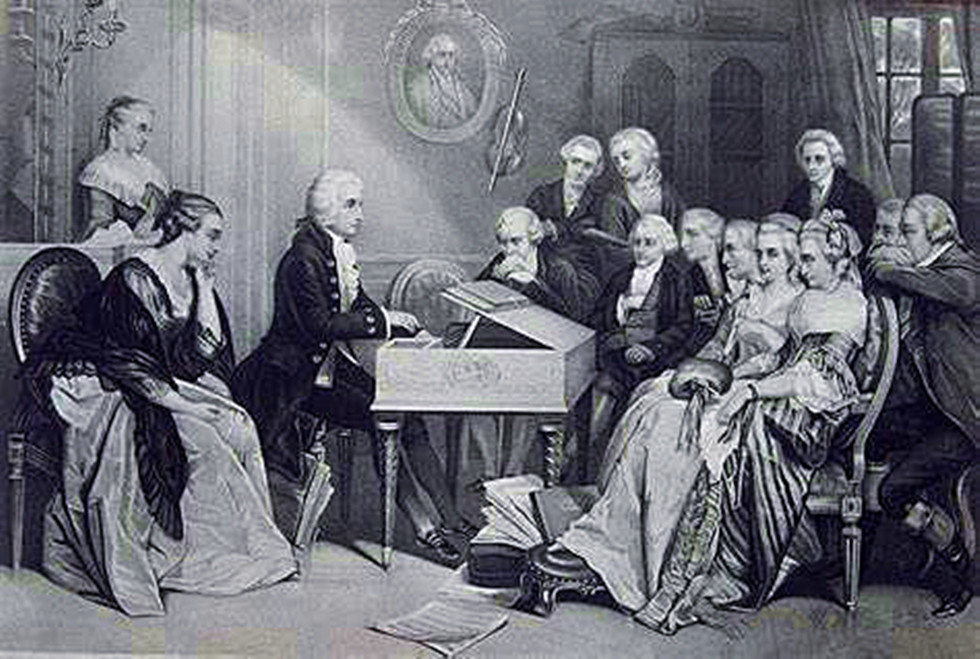 |
|
| |
莫扎特时代的家庭音乐会(wolfgang
amadeus mozart family concer) |
|
|
|
| |
August 18, 1773
Mozart: "Playsong No. 7" premiered at Dr. Mesma's garden concert in
Vienna.
Mozart is in his 17th year of life, already famous as a musical prodigy,
and his family's three trips to Italy, which began in 1769, have come to
an end.Trip to Italy for the first time, west to Turin, Italy, south to
napoli, thirteen Mozart comes at a good time, song all the way along the
way, view composition, all the way walk all the way to write, play,
visited celebrity, research a lot of Europe and even the culture of the
world, when Mozart was born at this time it was so, creating a more
brilliant movement, it was travelling is better than reading thousands
of books;The second trip to Italy in 1771;The third trip to Italy in
1772 covered all the mountains and rivers of Italy.Mozart composed the
"Playsong No. 7" in Italy and premiered it at Dr. Mesma's garden concert
in Vienna on August 18, 1773.
The first the first divertimenti step dance is often the soloist in the
music playing alone at the meeting, including the famous Philippine sea,
enclosed is some of the first small step dance skills adapted to bow to
play, more add infinite pleasure to the song, as a repertoire,
wonderful, solo music at the first pure small dance music is the best
test.
In Berlin philharmonic ensemble, we saw so many music group, is like a
person to play, played the violin clear, not only pure timbre and each
note is clear, Mozart's music really noble and pure, for many years the
palace dance to the rhythm of nobles are stepping on a small step, just
dance, so the popularity of the first small step dance music, so he has
a few hundred years has become the people are very loving and loved a
Mozart violin.
Divertimento was originally an instrumental ensemble for entertaining
guests in the 18th century. It is often played with more than 3 ~ 10
orchestral instruments. It contains more than 4 movements, mainly dance
(the most common is minuet, and can be more than one), march and
variation, and its form is similar to serenade.Both J. Haydn and W.A.
Mozart wrote large Numbers of frolics.F. Schubert's Hungarian
Playfulness is a fantasia based on Hungarian tunes.Frolics for piano and
five wind instruments by The French composer A. Roussel, and frolics for
flute and orchestra by F. Busoni, are both twentieth century
compositions.B. Bartok, I.F. Stravinsky, and H.W. Hentze also wrote
various forms of playtime, interspersing them with dance pieces from
operas, dance pieces, and other plays.
Divertimento, a light suite popular in the 18th century, is a common
form of Western classical music.At that time, it was mainly used for
entertainment, social intercourse and celebration in upper class and
court life (mainly in Austria). Compared with serenade, it was mainly
used for playing outdoors, while playtime was mainly used for playing
indoors.Divertire is derived from the Italian word divertire, meaning
joy and amusement.As a small chamber ensemble instrumental music, its
instrument composition, number of movements and form are very free.The
ensemble usually consists of three to eight players, and usually
consists of three to ten small movements. The genre of each movement is
usually dominated by dance music (especially minuet), march, variations
and sonata form, etc., without strict restrictions.
In the eighteenth century, Both Haydn and Mozart wrote a great deal of
playfulness.It was not until the early 20th century, when chamber music
and the revival of classical music began to take off, that some modern
composers attempted to write playfulness again.
Divertimento was originally an instrumental ensemble for entertaining
guests in the 18th century. It is often played with more than 3 ~ 10
orchestral instruments. It contains more than 4 movements, mainly dance
(the most common is minuet, and can be more than one), march and
variation, and its form is similar to serenade.Both J. Haydn and W.A.
Mozart wrote large Numbers of frolics.F. Schubert's Hungarian
Playfulness is a fantasia based on Hungarian tunes.Frolics for piano and
five wind instruments by The French composer A. Roussel, and frolics for
flute and orchestra by F. Busoni, are both twentieth century
compositions.B. Bartok, I.F. Stravinsky, and H.W. Hentze also wrote
various forms of playtime, interspersing them with dance pieces from
operas, dance pieces, and other plays.
Divertimento, a light suite popular in the 18th century, is a common
form of Western classical music.At that time, it was mainly used for
entertainment, social intercourse and celebration in upper class and
court life (mainly in Austria). Compared with serenade, it was mainly
used for playing outdoors, while playtime was mainly used for playing
indoors.Divertire is derived from the Italian word divertire, meaning
joy and amusement.As a small chamber ensemble instrumental music, its
instrument composition, number of movements and form are very free.The
ensemble usually consists of three to eight players, and usually
consists of three to ten small movements. The genre of each movement is
usually dominated by dance music (especially minuet), march, variations
and sonata form, etc., without strict restrictions.
In the eighteenth century, Both Haydn and Mozart wrote a great deal of
playfulness.It was not until the early 20th century, when chamber music
and the revival of classical music began to take off, that some modern
composers attempted to write playfulness again.
Today's video: 1. Karajan conducts the Berlin Philharmonic to perform
Mozart's "Tour No. 17" k334 at the 750th anniversary concert of the
founding of the city of Berlin; 2, Mozart "Minuet" dance version, the
picture is very beautiful; 3. Heifetz & Mozart - Minuet in D Major &
Violin (adapted from Mozart's "Rodeo No. 17"). |
|
|
|
| |
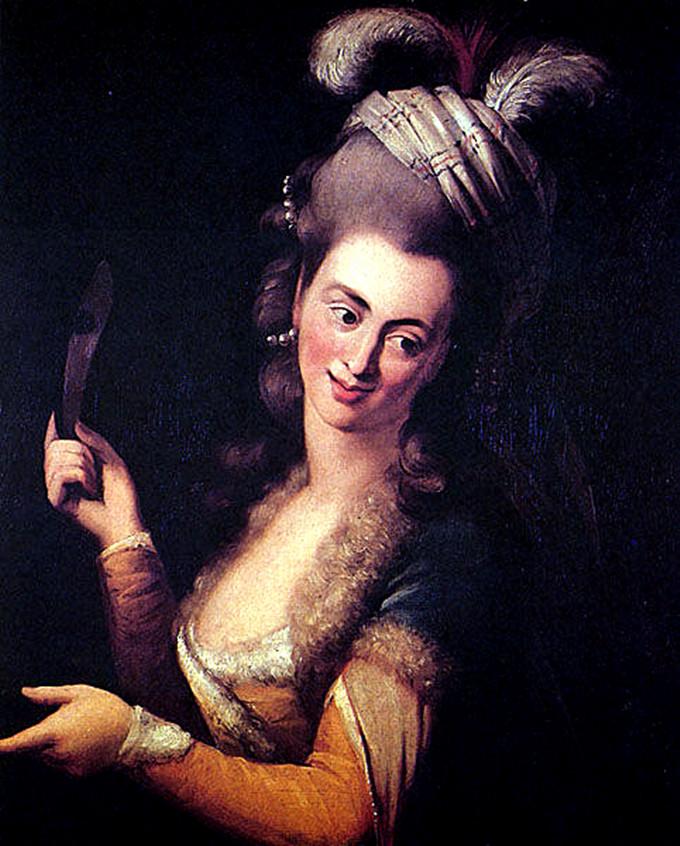 |
|
|
|
| |
莫扎特的初恋情人,韦伯的二女儿阿罗伊齐亚·韦伯(Aloysia
Weber) |
|
|
|
| |
Mozart's first
love, Weber's second daughter Aloysia Weber |
|
|
|
| |
莫扎特一生只爱姐妹俩 |
|
|
|
| |
关于莫扎特爱情的说法,有很多版本。不过,莫扎特一生真正爱过的女人有两个,而且还是姐妹俩。他们分别是德国著名音乐家韦伯尔的二女儿阿罗伊齐亚和三女儿康斯坦齐亚。
初恋,被情人利用后抛弃
莫扎特的初恋情人就是韦伯尔的二女儿阿罗伊齐亚,1777年,莫扎特在德国曼海姆遇上了她。16岁的阿罗伊齐亚一开口,莫扎特就被她迷住了。她那清澈美妙的高音,就和她的人一样,令人神往。
为了帮助阿罗伊齐亚征服音乐界,莫扎特为她创作了3首咏叹调,并带她出席宫廷音乐会。但面对莫扎特的追求,阿罗伊齐亚始终与他若即若离。阿罗伊齐亚考虑的只是音乐的成功:她梦想到意大利的歌剧院演唱。陶醉在柔情蜜意中的莫扎特写信给身在萨尔茨堡的父亲,请求他通过熟人在意大利为阿罗伊齐亚谋求一个女演员的空缺。
然而,莫扎特的父亲觉得他们俩并不合适:“立即去巴黎,功成名就后再去意大利。”
莫扎特无奈带着母亲离开萨尔茨堡去了巴黎。短短几个月,他创作了很多作品,但根本无法高兴起来,他无时无刻不在思念心上人。就在这时,他的母亲因旅途艰难、劳累过度患重病死在他怀里。父亲获悉情况后,催他回萨尔茨堡。
莫扎特两手空空返回德国。途径慕尼黑时,他顺便到韦伯尔家拜访,没想遭到阿罗伊齐亚的冷遇。因为她当时已是歌剧院女主角、当地的名流。莫扎特对她来说已经没有什么利用价值了。
1781年3月,阿罗伊齐亚嫁给了一名宫廷音乐家,这更让莫扎特伤心欲绝。
婚后,家里更像疯人院
尽管阿罗伊齐亚无情地抛弃了莫扎特,但他和韦伯尔家依然来往甚密。不久,17岁的三女儿康斯坦齐亚喜欢上莫扎特。他们悄悄相爱了。
尽管未经父亲同意,1782年8月4日,26岁的莫扎特和19岁的康斯坦齐亚还是举行了婚礼。婚礼上,双方亲属中只有康斯坦齐亚的妹妹索菲亚一个人出席。
婚后,莫扎特和康斯坦齐亚的生活非常甜蜜。在一起的时候,他们总是沉迷在那种孩子气似的性游戏中。一次,到莫扎特家做客的老莫扎特回来对女儿抱怨,儿子的家更像是疯人院——一天到晚音乐声不断,还伴有婴儿的啼哭声、狗的吠叫声以及金丝雀的鸣叫声。
或许正是如此,莫扎特的艺术细胞真正被激发了出来,婚后一两年,莫扎特迎来了他事业的颠峰时期。
死时,只有妻妹在身边
康斯坦齐亚在音乐上也非常有天赋,此外,她还是个天生的语言学家,除了会说母语德语外,还会说一口流利的意大利语和法语。莫扎特在给自己父亲的信中写道:“她非常漂亮,很爱干净,一个女人该具有的美好品质她都拥有。我爱她,她也全身心地爱我。”18世纪90年代,康斯坦齐亚由于多次怀孕,患上了一种致命的病。
1791年12月4日夜晚,莫扎特处在弥留之际,只有妻妹索菲亚守在他床边,她事后说:“莫扎特在生命最后一刻,还模仿《安魂曲》,我听见了。”莫扎特离开人世被埋葬在穷人的公墓里,下葬时没有一个亲人在身旁。 |
|
|
|
| |
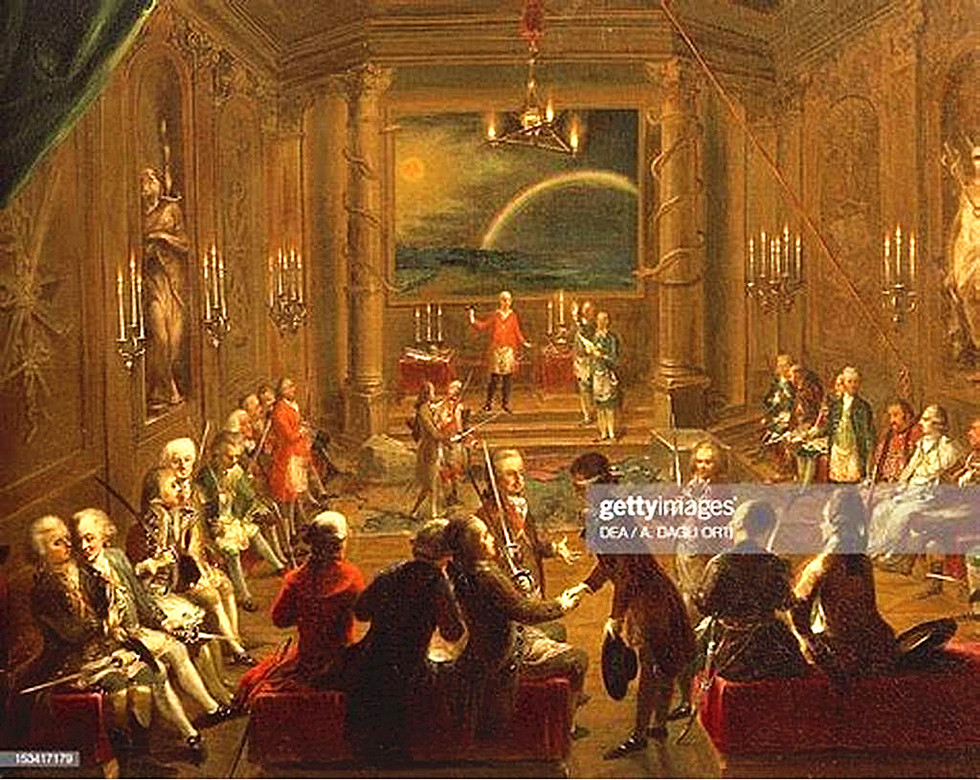 |
|
| |
莫扎特时代的共济会集会 |
|
|
|
| |
A Masonic meeting
in Mozart's time |
|
|
|
| |
|
|
|
|
| |
莫扎特《小步舞曲》配舞版,画面很美 Mozart's Minuet. It's beautiful |
|
|
|
| |
|
|
|
|
| |
Mozart loved only
the sisters all his life
There are many versions of Mozart's love story. However, Mozart really
loved two women in his life, and they were sisters. They are the second
daughter of the famous German musician Weiber, Alozia and the third
daughter Konstanzia.
First love, used and abandoned by the lover.
Mozart's first love was Weiber's second daughter, Alozia, whom he met in
Mannheim, Germany, in 1777. As soon as 16-year-old Alozia opened her
mouth, Mozart was charmed by her. Her high, clear, beautiful voice, like
her people, was fascinating.
To help Alozia conquer the music world, Mozart composed three arias for
her and took her to court concerts. But in the face of Mozart's pursuit,
Alozia has always been aloof from him. Alozia thought only of musical
success: she dreamed of singing in Italian opera houses. Intoxicated
with affection, Mozart wrote to his father in Salzburg, asking him to
seek an opening for an actress for Alozia in Italy through an
acquaintance.
However, Mozart's father felt that they were not compatible: "Go to
Paris at once, and then go to Italy as soon as you are successful."
Mozart had no choice but to leave Salzburg for Paris with his mother. In
just a few months, he created a lot of works, but he could not be happy
at all. He missed his sweetheart all the time. At this time, his mother
died in his arms from a serious illness caused by the difficult journey
and overwork. When his father learned of the situation, he urged him to
return to Salzburg.
Mozart returned to Germany empty-handed. On his way to Munich, he
stopped by the Webbers' house, not expecting a cold reception from
Alozia. Because she was already an opera diva and a local celebrity.
Mozart was no longer of any use to her.
In March 1781, Alozia married a court musician, which made Mozart even
more heartbroken.
After marriage, home is more like a madhouse
Although Alozia had ruthlessly abandoned Mozart, he remained close to
the Webbers. Soon her third daughter, 17-year-old Constanzia, fell in
love with Mozart. They fell in love quietly.
On August 4, 1782, Mozart, 26, and Constanzia, 19, married without their
father's consent. At the wedding, only Konstanzia's sister Sofia was
present.
After their marriage, Mozart and Constanzia lived a very sweet life.
When they are together, they are always indulging in childish sex games.
On one occasion, the old Mozart, who had been a guest at Mozart's house,
came back and complained to his daughter that his son's house was more
like a madhouse - there was music all day long, accompanied by the cries
of babies, the barking of dogs and the chirping of canaries.
Perhaps it is this that Mozart's artistic cells were really stimulated,
and a year or two after his marriage, Mozart ushered in the peak period
of his career.
Only his sister was with him when he died
Konstanzia is also very talented musically, and in addition, she is a
natural linguist, speaking fluent Italian and French in addition to her
native German. Mozart wrote to his father: "She is very beautiful, very
clean, she has all the good qualities a woman should have." I loved her
and she loved me with all her heart." In the 1790s, Constanzia suffered
a fatal illness as a result of her repeated pregnancies.
On the night of December 4, 1791, Mozart was dying, only his wife's
sister Sofia was at his bedside, she said later: "Mozart in the last
moment of life, but also imitate the Requiem, I heard." Mozart died and
was buried in a poor man's cemetery without a family member.
|
|
|
|
| |
|
|
|
|
| |
海菲兹 &
莫扎特-D大调小步舞曲 & 小提琴 Heifetz plays Mozart-Minuet
(Divertimento No.17, K.334) |
|
|
|
| |
海菲兹演奏莫扎特的小步舞曲(第17号,K.334)
theheifetzcollection
2011年3月27日
威利·伯梅斯特编曲
小提琴:亚沙·海菲兹
钢钢琴:伊西多尔·阿克伦
嬉游曲第17号,K. 334 |
|
|
|
| |
Heifetz
plays Mozart - Minuet (Divertimento No.17, K.334)
theheifetzcollection
2011年3月27日
Transcription/Arrangement by Willy Burmeister
Violin: Jascha Heifetz
Piano: Isidor Achron
Divertimento No. 17, K. 334 |
|
|
|
| |
|
|
|
|
| |
未得原作者编者授权严禁转载www.mt77.com任何内容 |
|
|
|
|
|
|
|
|
|
|
|
|
|
|


